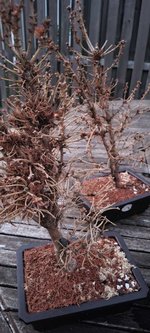ManSkirtBrew
Mame
Ever since I got my first completely beautiful (and doomed) juniper bonsai as a gift some 10+ years ago, I've consistently killed every confier I've tried to grow.
I have excellent success with everything else, from citrus to deciduous trees to succulents, but I cannot keep a conifer alive, and I'm starting to get frustrated.
I managed to keep this nursery procumbens nana alive for 3 years in a gallon pot. Early this spring I moved it to a different, tall pot, with the idea of gently acclimating it to a deep cascade pot. Planted it in Bonsai Jack conifer soil, and continued taking care of it how I normally do.
Every other week I feed it Neptune's Harvest, and every alternate week Dyna-Gro Grow 7-9-5. It seemed to take to its new pot and its sunny spot in the backyard.
Last week we had a lot of rain, and today 90 degree heat. I went out for its normal fertilizing and came out to this:

Too much water? Too much sun? Fungal infection? I can get more pictures in the sun tomorrow if it helps.
Then there's his little buddy, a pre-bonsai that I got from a nursery about 2 years ago. It's doubled in size since I got it, and seemed super healthy. I repotted it at the same time as the nana. Today I'm seeing some brown tips and it looks overall unhappy.

Halp!
I have excellent success with everything else, from citrus to deciduous trees to succulents, but I cannot keep a conifer alive, and I'm starting to get frustrated.
I managed to keep this nursery procumbens nana alive for 3 years in a gallon pot. Early this spring I moved it to a different, tall pot, with the idea of gently acclimating it to a deep cascade pot. Planted it in Bonsai Jack conifer soil, and continued taking care of it how I normally do.
Every other week I feed it Neptune's Harvest, and every alternate week Dyna-Gro Grow 7-9-5. It seemed to take to its new pot and its sunny spot in the backyard.
Last week we had a lot of rain, and today 90 degree heat. I went out for its normal fertilizing and came out to this:

Too much water? Too much sun? Fungal infection? I can get more pictures in the sun tomorrow if it helps.
Then there's his little buddy, a pre-bonsai that I got from a nursery about 2 years ago. It's doubled in size since I got it, and seemed super healthy. I repotted it at the same time as the nana. Today I'm seeing some brown tips and it looks overall unhappy.

Halp!

